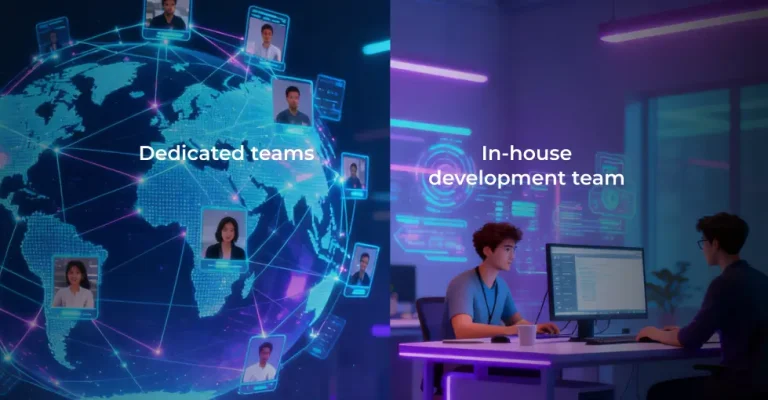In today’s competitive tech landscape, software outsourcing and staff augmentation are evolving from tactical fixes into strategic levers for growth. A recent Deloitte survey found that 40% of executives plan to increase investments in third-party outsourcing, underscoring its role in long-term value creation.
This guide highlights key staff augmentation scenarios and demonstrates how it can strengthen delivery capacity while keeping strategic control in-house. Read on for actionable recommendations on when to use staff augmentation based on your specific product goals, business challenges, and the development strategies leveraged by your product teams.
What is IT staff augmentation?
IT staff augmentation is an outsourcing model where companies bring in external professionals to work alongside their in-house teams. It’s a flexible way to close skill gaps, scale engineering, design, and management capacity for projects, and avoid the long timelines and costs of permanent hiring. These specialists remain employed by the augmentation provider but integrate into your team’s workflow, giving you access to vetted talent without extra overhead.
If you’re weighing staff augmentation against other approaches, such as project-based outsourcing, check out our guide on Staff Augmentation vs Project-Based Outsourcing: Which Model Fits Your Needs? for a side-by-side comparison.
Key benefits and how to unlock them
Cost-saving compared to in-house
Hiring full-time employees is expensive beyond salaries. Companies also carry the cost of benefits, insurance, office space, equipment, and training. With IT staff augmentation, those overheads stay with the provider. You only pay for the hours worked or project milestones delivered, which makes budgets easier to manage and avoids tying up capital in long-term commitments. AgileEngine’s 2025 Tech Salary Report: USA vs. Nearshore and Offshore Locations highlights how global hiring models can create significant payroll savings, further reinforcing the financial advantage of staff augmentation.
Flexibility and scalability
Business needs aren’t steady, and IT workloads often come in waves. A seasonal influx of new clients may suddenly increase demand, or an upcoming product launch may require more specialists to handle engineering tasks. Staff augmentation lets you scale up fast for these spikes and contract again when the pressure eases, without layoffs or sunk hiring costs. This level of flexibility helps companies stay lean while still delivering at pace.
It’s also useful for covering temporary gaps. If a key developer is on leave or a project requires a short-term skill set, augmentation provides a stopgap solution. Instead of delaying delivery or overloading your core team, you can maintain momentum with external support that slots in as needed.
Access to specialized and niche skills
Not every project calls for skills you want to keep on staff year-round. For example, you might need a machine learning engineer for a six-month AI feature build, or a cybersecurity expert to run a one-time audit. Recruiting for these niche roles can be slow, costly, and sometimes impossible in your local market. Staff augmentation solves this by giving you immediate access to specialists with rare expertise — something that’s become even more feasible as tech industry layoffs reshape the talent market and make highly skilled professionals available to startups and SMBs.
This access also reduces risk when experimenting with new technologies. Say you want to explore a move to cloud-native architecture but aren’t ready to commit to a permanent cloud team. Augmented staff let you test and learn with skilled professionals before deciding whether to invest in those capabilities long-term. It’s a practical way to keep up with fast-changing tech without overextending your hiring strategy.
Faster hiring and onboarding, which leads to faster time-to-market
IT staffing vendors accelerate hiring by drawing from extensive networks of pre-screened professionals and using technology-enabled processes like automated matching and digital interview platforms. This allows companies to bypass long recruitment cycles, quickly bring in specialized talent, and integrate them into ongoing projects with minimal disruption. The result is shorter time-to-market, reduced project delays, and the flexibility to scale teams in response to changing demands.
Retaining knowledge while scaling resources and talent
While staff augmentation is often seen as a short-term fix, it can also preserve valuable expertise within projects over the long run. External professionals, once onboarded, work directly with in-house teams, helping transfer knowledge, processes, and best practices that remain even after the engagement ends. This continuity means businesses can scale up or down without losing the insights, documentation, and experience that keep projects running smoothly.
Better control vs. project-based staffing
Unlike project-based outsourcing, where vendors may run operations independently, staff augmentation keeps decision-making firmly in the company’s hands. Businesses directly manage augmented professionals as part of their internal teams, ensuring alignment with culture, workflows, and quality standards. With the right monitoring and management processes in place, companies gain both the flexibility of external talent and the control of in-house execution.
Common challenges and how to overcome them
Time zone differences
Working across different time zones can sometimes slow collaboration, especially in offshore models with little overlap in working hours. The key to overcoming this is structured communication protocols, such as agreed “golden hours” where teams meet, along with asynchronous tools like Slack or Jira that keep progress transparent. With the right vendor, time zone differences can actually become an advantage, enabling round-the-clock productivity and faster project cycles.
Team integration and cultural fit
Blending external professionals into established teams can create challenges in communication styles, work habits, or cultural alignment. Reputable high-quality vendors address this by assessing not just technical skills but also values, communication preferences, and team dynamics during recruitment. Combined with onboarding, team-building exercises, and open feedback loops, this ensures that augmented staff integrate smoothly and enhance team cohesion, minimizing disruption.
Maintaining quality and accountability
Without proper oversight, companies risk inconsistencies in performance or deliverables when adding external talent. To avoid this, experienced vendors establish clear quality standards, reporting structures, and regular check-ins that keep expectations aligned. By combining project management tools with dedicated leads or QA processes, staff augmentation becomes a predictable way to scale with confidence, while ensuring accountability at every step.
Knowledge transfer and documentation
Knowledge gaps can emerge if insights are not effectively shared between in-house and augmented professionals. Strong vendors mitigate this risk by setting up structured documentation, shared dashboards, and mentorship programs that make information accessible and sustainable. This way, knowledge transfer becomes a driver of long-term resilience, ensuring projects don’t depend on any single individual.
Security, compliance, and IP protection
Giving external professionals access to sensitive systems naturally raises questions about data security and compliance. Certified vendors address this head-on with robust access controls, NDAs, and adherence to internationally recognized standards such as ISO 27001 or PCI DSS. By selecting a partner with proven security protocols, companies not only protect their intellectual property but also strengthen their compliance posture.
Risk of overreliance on vendors
Depending too heavily on external staff can create continuity risks if knowledge and processes remain siloed. The best approach is to view staff augmentation as a partnership where documentation, training, and reporting ensure knowledge stays within the organization. Vendors who emphasize co-creation and skills transfer help companies stay agile, balancing external support with internal capability building.
Types of Staff Augmentation models
When companies talk about staff augmentation, they often mean different engagement styles depending on duration, team setup, or geography. Each approach offers unique benefits, from short-term flexibility to building dedicated teams for long-term engagements. Understanding these models will help you select the right fit for your project goals, budget, and collaboration style.
By duration
| Model | Description | Best for |
| Short-term / on-demand | External professionals hired for a limited time to handle spikes in workload, urgent deadlines, or last-mile project needs. | Quick fixes, seasonal demand, end-phase support. |
| Long-term | Talent embedded in your team for several months or years, becoming an integral part of ongoing projects. | Sustained projects, building stable extended teams. |
Dedicated teams
Easier collaboration compared to rotating staff
- What they are: A group of professionals (often cross-functional) assigned exclusively to your project or product.
- How it works: They work as an extension of your team but remain employees of the provider.
- Advantages:
- Consistency and strong alignment with company culture
- Faster ramp-up and long-term knowledge retention
| Model | Model | Model |
| Onshore | Hiring talent within the same country or region. | Easier communication, cultural alignment. |
| Nearshore | Hiring from neighboring countries with close time zones. | Cost savings with better time overlap and cultural fit. |
| Offshore | Hiring from distant countries, often in different time zones. | Largest talent pool, cost efficiency, 24/7 operations possible. |
To help assess the business impact of each option, see the recent AgileEngine comparison of nearshore, offshore, and onshore models — it highlights how nearshore frequently offers 30–50% cost savings versus onshore, while still enabling efficient real-time collaboration due to time zone and cultural alignment
Comparing outsourcing models
Staff augmentation isn’t the only way to scale software delivery. Options like freelancing, project outsourcing, managed services, or consulting all serve different business needs. By comparing these models side by side, you can see how staff augmentation provides a flexible middle ground. This model offers both control and scalability without locking you into rigid contracts or long hiring cycles.
| Feature | Staff augmentation | Freelancing | Project outsourcing | In-house hiring | Managed services | Consulting |
| Control | Full alignment with your processes and workflows. | You define tasks, freelancers manage delivery. | Vendor drives execution, you focus on outcomes. | Complete control over employees and culture. | Shared responsibility, guided by SLAs. | You set goals, consultants guide direction. |
| Commitment | Flexible — short- or long-term depending on need. | Typically short-term or task-based. | Project-based until delivery. | Long-term, permanent positions. | Ongoing partnership for continuous functions. | Short-term, focused on strategic challenges. |
| Cost | Efficient — pay only for skills when needed. | Budget-friendly for defined tasks. | Predictable, often fixed per project. | Greater investment for stability and integration. | Subscription-style, predictable over time. | Premium investment for high-level expertise. |
| Flexibility | High — scale teams up or down quickly. | High — fast access to niche skills. | Best suited for clear, stable scopes. | Lower — scaling takes time. | Adjustable within contract terms. | High — engage experts when needed. |
| Talent pool | Global, pre-vetted professionals ready to join. | Broad, worldwide availability. | Vendor’s specialized teams. | Limited to your recruiting reach. | Provider’s domain experts and tools. | Niche, top-level experts in specific areas. |
How to implement software project staffing successfully
Choosing the right model is only half the story. The real success of remote development initiatives depends on how you implement and manage them. From defining the right skill requirements to onboarding talent and tracking results, there are a few best practices that can help you make the most of staff augmentation.

1. Identify skill gaps & define goals
Rank priorities so you know which skills are non-negotiable and which can be ramped up with training.
Go beyond “roles” — break down required technical depth, domain expertise, and soft skills.
Define outcome-based goals (e.g., reduce release cycle by 30%) instead of just filling a seat.
2. Choose the right partner
Check whether they can scale a single developer into a dedicated team if the project grows.
Evaluate not just talent supply, but the vendor’s recruiting speed, retention rates, and client references.
Ask about their cultural alignment practices (language skills, time-zone overlap, team integration).


3. Onboard and collaborate effectively
Establish routines — daily stand-ups, sprint planning, retros — to give augmented staff the same visibility as full-time employees.
Set up a structured onboarding plan: systems access, tool training, security protocols.
Assign an internal buddies/mentors to accelerate integration and knowledge transfer.
4. Monitor progress and team health
Create a shared success scorecard so both in-house and augmented staff feel ownership of results.
Measure output, not just activity: code quality, velocity, defect rates, business impact.
Run regular pulse checks to spot engagement or cultural friction early.


5. Use the right tools to manage progress
Review SLAs or KPIs monthly to ensure alignment between client leadership and vendor.
Standardize collaboration with cloud-based project management and version control (e.g., Jira, Confluence, GitHub).
Define a clear escalation path for risks and blockers.
6. Facilitate knowledge transfer and sharing
Gather feedback on both sides (e.g., what worked well, what to adjust) and use it to refine future engagements.
Build a living knowledge base so expertise stays in-house after contracts end.
Include augmented staff in retrospectives and lessons learned to improve processes together.

Measuring the ROI of staff augmentation

Like any investment, staff augmentation should be evaluated in terms of the value it generates for your business. Measuring ROI helps understand how faster delivery, reduced overhead, and access to specialized expertise translate into measurable business outcomes. By tracking the right KPIs, weighing short- and long-term impact, and knowing when to shift strategies, you can ensure staff augmentation drives profitability and sustainable growth.
KPIs to track
Industry experts recommend these KPIs for measuring ROI and performance across IT staff augmentation and remote software development projects:
- Speed to delivery: Time-to-Productivity (ramp-up time) measures how quickly augmented staff become fully productive; target is under 3 weeks. Sprint Velocity tracks work throughput per sprint to gauge delivery consistency.
- Cost efficiency: Beyond hourly rates, factor in avoided overhead like recruitment, benefits, and training costs. Cost per Hire and total hiring costs are tracked to optimize spending.
- Code quality: Metrics such as defect density, test coverage, and pull request rejection rates are essential. Lower technical debt measured through these metrics improves maintainability and impacts long-term ROI.
- Utilization rate: Percentage of developer time spent on productive, billable tasks; ideal range is 75–85%.
- Client and stakeholder satisfaction: Regular feedback surveys and retention rates gauge alignment and partnership health.
KPIs must be relevant and linked directly to company strategy to provide meaningful insights. You want to avoid getting overwhelmed by too much raw KPI data or assuming one set of KPIs fits every team. Instead, choose the KPIs that truly matter to your goals, check them regularly, and use them to keep your team aligned and working toward the same objectives. When you approach KPIs this way, they become effective tools that help you make smarter decisions and deliver real value — not just numbers on a report.
Balancing short-term vs long-term value
Staff augmentation can deliver quick wins by helping companies overcome talent shortages and expedite design and development. The greater return, however, comes with longer-term engagements. Over time, augmented developers build domain knowledge, adapt to company culture, and collaborate more effectively with in-house teams.
When evaluating ROI, it’s important to look beyond project costs and factor in reduced attrition, lower onboarding effort, and the continuity that supports ongoing innovation. Viewed this way, staff augmentation becomes an effective long-term strategy for scaling growth.
Signs it’s time to transition to in-house hiring
There are moments when ROI signals a need to convert augmented talent into full-time employees. If certain roles remain mission-critical across multiple projects, and for extended periods , closing them with in-house hires may prove a more stable long-term option.
That said, it’s not always about the length of the engagement. Many companies successfully collaborate with the same remote developers for 5+ years and trusted vendors for a decade or more, maintaining continuity, without transferring their roles to internal hires. The key is recognizing whether your business needs permanent ownership of the role — or if long-term augmentation already delivers the best ROI.
Industry applications and examples
Staff augmentation can deliver impressive results across diverse scenarios — from startups racing to launch digital products and tech companies expanding features, to enterprises managing variable demands and strict compliance requirements. The model is excellent for scaling agile teams and meeting close, critical deadlines, making it essential for IT decision-makers.
Startups building and scaling MVPs
For startups, staff augmentation means instant access to the right expertise to get an MVP off the ground quickly. Instead of building a large permanent team, they can engage specialists just long enough to launch and test their product, reducing overhead and speeding up market entry.
Product companies expanding to new markets or building new features
When adding new capabilities or entering different markets, product companies often need niche skills for short bursts of time. Staff augmentation makes it easy to bring in experts — whether for compliance, integrations, or new tech features — without slowing down release cycles.
Enterprises handling fluctuating workloads
Large organizations see demand peaks and valleys across the year. Augmented teams allow them to scale up quickly during busy periods, then scale back without carrying excess staffing costs, ensuring resources are always aligned with business needs.
Scaling agile teams
Agile environments thrive on flexibility. Staff augmentation supports this by letting teams add Scrum Masters, QA specialists, or other roles as needed, helping them maintain velocity and adapt to shifting priorities without breaking rhythm.
Meeting critical deadlines
When deadlines are non-negotiable — due to compliance requirements, product launches, or contractual obligations — augmentation provides immediate access to senior talent that can step in and deliver under pressure, avoiding costly delays.
Operating in highly regulated industries
Finance, healthcare, and other regulated industries demand compliance expertise that isn’t always available in-house. Augmented professionals with specialized knowledge ensure that systems are secure, compliant, and delivered with confidence.
Future of Staff Augmentation (2025 and Beyond)
AI-driven talent sourcing and matching
According to the 2025 AI in Hiring Survey by Insight Global, 99% of hiring managers reported using AI in some capacity during the hiring process. AI-driven platforms automate candidate screening and skill matching, helping to identify best-fit candidates faster and more accurately than traditional methods, dramatically reducing time-to-hire and improving hiring efficiency by 98%.
Additionally, 74% of hiring managers believe AI assists in assessing compatibility between applicants’ profiles and job requirements, supporting smarter matches and reducing costly mismatches. However, human judgment remains critical for holistic evaluation and culture fit in hiring decisions. This powerful combination of AI efficiency and human insight ensures that augmented staff integrate well and deliver value quickly.
Rise of global, remote-first teams
The global talent pool is now more accessible than ever, thanks to advances in communication technologies and shifting work cultures toward remote and hybrid models. Companies are expanding their search geographically to tap into diverse skill sets beyond local markets. Remote-first teams bring greater flexibility and cost efficiency, enabling businesses to increase productivity by collaborating with top-skilled experts across time zones.
Hybrid teams and mixed models
Staff augmentation is increasingly being combined with other workforce models—such as in-house teams, managed services, and project outsourcing—to create hybrid strategies that balance control and flexibility. This blended approach lets organizations leverage the strengths of each model: the agility and niche expertise of augmentation, the stability of permanent staff, and the efficiency of external vendors. The result is a more resilient and adaptive technology team poised for ongoing innovation.
Conclusion
IT staff augmentation stands as a scalable and flexible resourcing strategy that empowers organizations to rapidly access specialized technical talent, manage fluctuating workloads, and mitigate hiring risks. It complements traditional in-house staffing and project outsourcing by blending external expertise with internal control, enabling faster delivery and innovation without long-term overhead.
For IT decision makers, exploring staff augmentation can unlock cost efficiencies, boost agility, and reduce time-to-market, making it a valuable option to evaluate against your team’s current and future resourcing needs. Consider if augmentation fits your strategic goals, and engage the right partners to maximize these benefits effectively.
FAQs
Can augmented staff become permanent employees?
In certain cases, remote professionals can transition to permanent roles if the business needs justify it, and if this transition is supported by the vendor. However, it is much more typical for companies to maintain long-term augmentation relationships without converting to full-time employment, balancing continuity and flexibility while avoiding the challenges associated with increasing internal headcount.
How do you ensure smooth onboarding and integration?
Smooth onboarding requires clear access provisioning, system training, and role alignment from day one. Assigning internal mentors accelerates cultural alignment and knowledge transfer. Structured routines like daily stand-ups, sprint planning, and shared collaboration platforms (e.g., Jira, Slack) help remote experts integrate seamlessly with in-house teams.
How does augmentation work for distributed agile teams?
In distributed agile teams, staff augmentation requires clear communication protocols with daily video stand-ups during overlapping hours, asynchronous updates via collaboration tools, and clearly defined sprint goals.
What are the best practices for knowledge transfer?
Effective knowledge transfer relies on documented processes, shared repositories, and active participation of augmented staff in retrospectives and team reviews. Implementing mentorship programs and using tools such as Confluence for documentation centralizes key insights, reducing dependency risks and retaining expertise even after augmentation contracts end.













